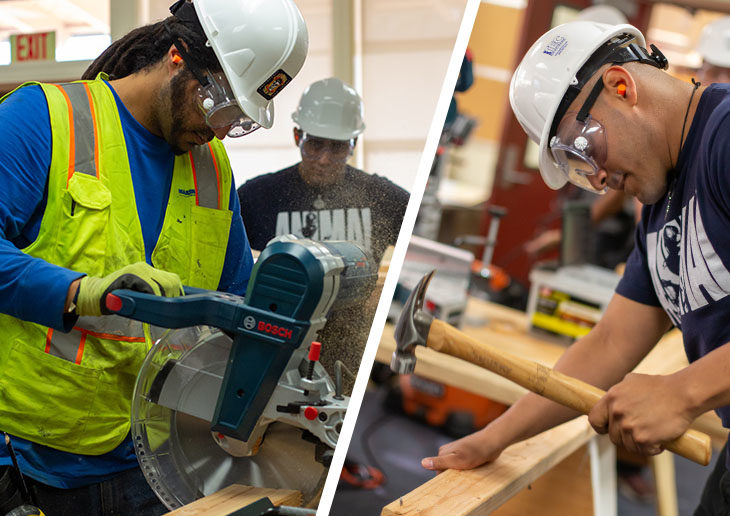Noncredit to Credit Pathways Lead to College and Careers at Santa Ana College Feature Story
July 31, 2020

Every year, more than 1,000 Santa Ana College School of Continuing Education noncredit students continue on the road to a college degree and enroll in credit courses. On top of that, as of fall 2019, more than 3,000 former noncredit students were taking credit courses at SAC, while 2,338 former SCE students were enrolled at four-year colleges. Even more impressive, 31 were identified as being enrolled in doctoral programs.
As part of this significant success, SAC’s unique Noncredit to Credit Pathways Project has been developing courses to connect individuals with the instruction and support they need to successfully transition not just from noncredit to credit classes, but also to careers.
“The whole thing behind these noncredit to credit pathways is to encourage students to move forward with their educations,” says Dr. Osiel Madrigal, workforce development coordinator, and associate professor and chair of the SCE Career and Technical Education Department. “Based on research, we know a higher degree means more job security and money down the line for students and their families. It also means SAC gets more students and regional businesses get more educated workers. It’s a win-win-win.”
In 2016, Madrigal joined SAC and inherited a nearly complete noncredit to credit pathway in pharmacy tech that had been developed by his predecessor, former professor Mike Arroyo. After putting the finishing touches on the pathway and finalizing approvals, Madrigal set his sights on expanding to other programs. At the time, such pathways were being pioneered in parts of the state like San Diego, but remained relatively uncommon across the community college landscape.
Today, SAC’s SCE has 10 pathways that are being offered or will be offered soon that not only lead from noncredit to credit classes, but also to careers. They are:
- Pharmacy Technology (Fall 2020)
- Automotive Technology (Fall 2020)
- Nursing – Certified Nursing Assistant (Fall 2020)
- Biotechnology (Spring 2020 pending final approval)
- Manufacturing (Spring 2020 pending final approval)
- Culinary (Spring 2020 pending final approval)
- Accounting – Quickbooks (Fall 2021 pending final approval)
- Welding (Fall 2021 pending final approval)
- Diesel Technology (Fall 2021 pending final approval)
“It’s been a lot of work over the last four years, but people are understanding why this is a good thing for everyone,” says former SAC SCE Special Programs Director and current Interim Dean of Instruction and Student Services Lorena Chavez. “We share a collective vision of how noncredit and credit can and should be working together to help students get basic training and advance their educations.”
Chavez, who was hired as part of a Strong Workforce Program grant in 2017 to help develop the infrastructure necessary to support these pathways, recalls a time when this was not the case, a time when institutional assumptions about “the noncredit side” had to be overcome.
“Our credit-side program partners and especially Director of Special Programs/Career Technical Education Kimberly Mathews deserve a lot of credit,” says Chavez. “Their support has been amazing from the start and they helped us to create those pathways by connecting us to various institutional partners.”
While various initiatives from the California Community Colleges Chancellor’s Office, such as the Vision for Success and Guided Pathways, have re-invigorated attention on the importance of noncredit pathways, noncredit programs have historically been viewed as secondary to the mission of community colleges. This perception created a dynamic in which noncredit programs were often seen as competing for students by offering the same classes for free.
“From the start, it was important to help programs understand that these courses weren’t here to steal students from them,” says Madrigal. “In fact, by offering free basic training and an introduction to a field and by focusing on the supports students need to transition to the credit side, we were developing these pathways to do just the opposite—to get more students into their programs.”
To do that, Madrigal and Chavez focused on addressing common obstacles that prevent noncredit students from taking credit classes. While the issues vary, Madrigal, who has been a professor at SAC since 2011 and who has seen these obstacles firsthand, points to a lack of basic skills and a lack of self-esteem as major contributing factors.
“They’re all capable,” says Chavez. “It’s just some of them don’t know that. So, we have to create touch points and structures that support them emotionally as well as academically.”
One practice Madrigal and Chavez focus on is creating “continuity of education” between courses so students see the credit courses as less different from the noncredit courses and therefore less intimidating. This practice takes many forms, including using the same instructor to teach both the noncredit and credit classes, and teaching noncredit and credit classes in the same facility.
A partnership with the Garden Grove Lincoln Education Center which has expanded the SCE’s facilities has made creating this continuity easier than ever. The site is currently home to SCE’s noncredit to credit automotive pathway, and will soon be home to the accounting, culinary, welding, and diesel technology pathways.
When it comes to basic skills, in addition to SCE’s robust ESL program, a Math for Career Education course will soon be offered to help students acquire the industry-specific math skills required by certain fields.
“In Pharm Tech, we noticed students doing great in the mirrored and articulated introduction class but getting hung up when it came to a credit-side pharmacy calculations class,” says Madrigal. “The challenge is that many of these careers don’t just require basic math skills, they require industry-specific math, so this class was designed to get students the skills they need to be successful based on what pathway they’re on.”
Both Madrigal and Chavez are quick to mention that it isn’t enough for their students to just succeed in credit courses—they want them to find careers. To make sure the courses and programs they develop are relevant to both students and regional workforce needs, they pay close attention to labor market information and what students are saying while working closely with regional partners.
The Pre-Apprenticeship Readiness Program for Construction and Building Trades pathway is a case in point. This 10-week program was developed in partnership with the Los Angeles/Orange County Building and Construction Trades Council and the Apprenticeship Readiness Fund to prepare students with the basic skills they needed to begin careers as trade apprentices.
“Everything from the program design to the integration of the hands-on component is based on their feedback and guidance,” says Chavez. “We even changed the name based on what they suggested. It used to be called vocational construction but they said, ‘We don’t know what that means.’ So, we changed the name to reflect the industry more accurately.”
This free program provides students with the skills needed for careers in cabinet making; green technologies; plumbing; cement masonry; heating, ventilation, and air conditioning (HVAC); surveying; and weatherization. The course’s comprehensive pre-apprenticeship multi-craft core curriculum (MC3) includes 140 hours of training, Occupational Safety and Health Administration (OSHA) 10 Certification, and CPR and first aid training that will help them obtain positions within the construction field.
While the impact of the COVID-19 pandemic has forced significant adjustments across Santa Ana College, Chavez and Madrigal have responded by remaining flexible and adopting the same “continuity of education” approach to supporting students. While COVID-19 caused 15 of this spring’s construction cohort to delay completion, Chavez assigned an instructional aide to support and maintain contact with them to keep them connected and on track to complete their course despite the delay caused by campus closures.
Additionally, fall classes that have a hands-on component will divide students between different days in order to reduce class sizes so they can continue instruction while observing social distancing guidelines.
Madrigal and Chavez are humble about what they’ve accomplished and eager to credit their institutional partners and the support of regional and local Strong Workforce programs. They are also eager to get working on what’s next.
“We need to grow, grow, grow,” laughs Madrigal. “The more programs we can add to this and more layers we create, the more opportunities we can offer students, and that’s what it’s all about.”
To learn more about the many noncredit to credit career education pathways offered by Santa Ana College’s School of Continuing Education, visit https://www.sac.edu/sce/programs/careereducation/Pages/default.aspx.




